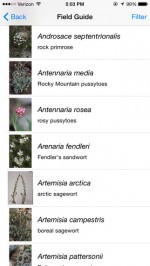A new plant recognition and field guide smartphone app, Luminous ID (luminousid.com), was launched this May after a yearlong collaborative project led by graduate student Nathalie Chardon at the University of Colorado, Boulder (CU). Project participants included CU’s Computer Science department, Environmental Studies program, Institute for Arctic and Alpine Research (INSTAAR), and the Niwot Ridge (NWT) Long Term Ecological Research (LTER) Program.
The app uses visual recognition software to identify the alpine cushion plant, Silene acaulis (Carophyllaceae) in photographs taken by users. When positively identified as S. acaulis, the photograph and GPS coordinates are uploaded to a server accessible to researchers. Silene acaulis is a common alpine species throughout the Northern Hemisphere, and information collected through this citizen science project will be used to quantify the spatial distribution of this plant. Chardon will use these observations in conjunction with topographic and climatic data to ascertain a clearer understanding of the factors limiting the range of S. acaulis.
The field guide component of the app includes 65 of the most common alpine forbs found at Niwot Ridge. Users can quickly identify plants by using a filtering function that narrows results by flower color and shape, petal number, inflorescence type, leaf shape and arrangement, and habitat. The alpine plant photographs and characteristics data included in the app were collected primarily by Jane G. Smith, a postdoctoral researcher at INSTAAR and NWT LTER.
In subsequent versions of the app, Chardon and Smith intend to expand the alpine flora to include all species found at Niwot Ridge, and to add field guide sections for insect and other animal identification. This field guide app will be a useful tool for recreational visitors to Niwot Ridge and the Indian Peaks Wilderness, as well as to scientists doing research in the Colorado alpine.

 Enlarge this image
Enlarge this image
